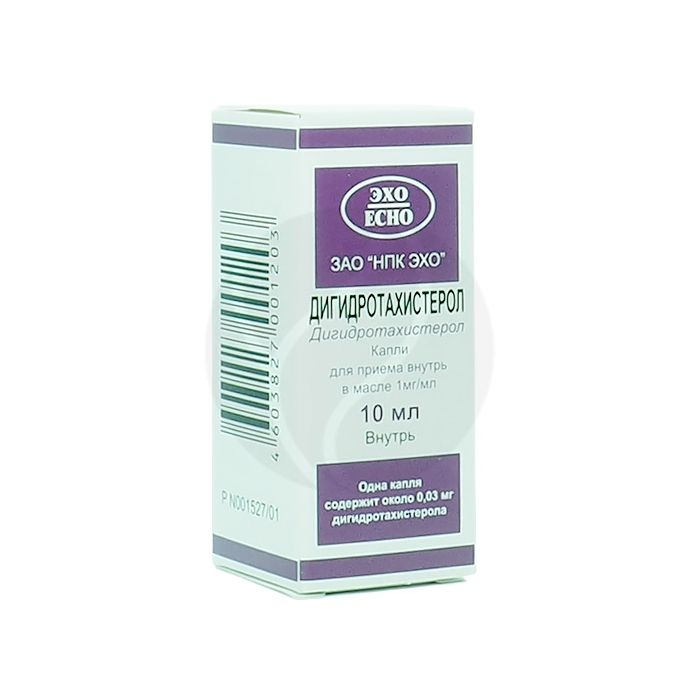Dihydrotachysterol drops for oral administration 0.1%, 10ml
Russian Pharmacy name:
Дигидротахистерол капли д/приема внутрь 0,1%, 10мл
Hypocalcemia associated with hypoparathyroidism (postoperative, idiopathic, tumor, sarcoidosis or tuberculosis),
tetany.
The drug is taken orally after meals. Dose with drops from an eye pipette or dropper stopper. One drop of the drug contains 0.03 mg of dihydrotachysterol; in 1 ml of the drug on average 33 drops. The dose is set individually, depending on the patient's condition and the content of calcium and phosphorus in the blood.
The daily dose is 17 to 50 drops (0.5 to 1.5 mg). On the 7-10th day of treatment, with pronounced positive shifts in the content of calcium and phosphorus in the blood serum, they switch to maintenance therapy, 17-50 drops (0.5-1.5 mg) per day, 1-3 times a week. Treatment is carried out for a long time (from 2-3 months to a year or more), depending on the nature of the disease. With the additional appointment of calcium preparations, it is possible to use smaller doses of dihydrotachysterol.
Oily solution for oral administration 0.1%, transparent, from light yellow to yellow, without rancid odor.
1 ml dihydrotachysterol 1 mg
Excipients: refined deodorized sunflower oil or refined deodorized soybean oil.
All diseases accompanied by hypercalcemia;
hypersensitivity to dihydrotachysterol and other vitamin D preparations;
hypervitaminosis D, hypermagnesemia;
organic lesions of the heart in the stage of decompensation;
childhood.
pharmachologic effect
Regulator of calcium and phosphorus metabolism. The chemical structure is close to ergocalciferol (vitamin D2). Increases the permeability of the intestinal epithelium for calcium and phosphorus. Regulates bone mineralization, as well as the process of calcium mobilization from bone tissue. Increases the excretion of inorganic phosphate by the kidneys.
Pharmacokinetics
After oral administration, it is well absorbed in the intestine, Cmax in plasma is reached 6 hours after administration. Absorption can be impaired in diseases of the liver, bile ducts or gastrointestinal tract. Dihydrotachysterol in the liver is converted mainly into two active metabolites - 25-hydroxyhydrotachysterol and 1?, 25-dihydroxyhydrotachysterol, which bind to receptors 1?, 25-dihydroxyvitamin D - the hormonal form of vitamin D, and exhibit a similar effect. Unlike vitamins D2 and D3, the formation of active metabolites of dihydrotachysterol is not feedback-regulated. Therefore, the concentration of 25-hydroxyhydrotachysterol in the blood increases linearly with an increase in the dose of dihydrotachysterol, which necessitates careful selection and control of its dose,providing a normal level of calcium in the blood and the absence of hypercalcemia. T1 / 2 of dihydrotachysterol is 10.5-13 hours. It is deposited in the liver, fat, skin, muscles and bones. Excretion: mainly through bile with feces. With long-term use of dihydrotachysterol in therapeutic doses, the concentration of dihydrotachysterol in plasma is linearly related to the value of the daily dose.
Side effect
Adverse reactions are mainly due to hypercalcemia.
From the digestive system: anorexia, nausea, vomiting, diarrhea; when used in high doses - biliary dyskinesia.
On the part of the cardiovascular system: palpitations; rarely - heart rhythm disturbances.
From the side of metabolism: thirst, tissue calcification.
From the urinary system: with prolonged therapy - impaired renal function.
Others: pallor of the skin, headache, allergic reactions.
Application during pregnancy and lactation
Use during pregnancy and breastfeeding is contraindicated.
Application for impaired renal function
It should be used with caution in patients with impaired renal function.
Application in children
Use in children is contraindicated.
Use in elderly patients
Calcium levels should be monitored in elderly patients with a sharp change in diet and exercise regimen.
special instructions
During the course of treatment, it is necessary to control the content of calcium and phosphorus in blood serum and urine at least 1 time / month at the initial stage of treatment, and after the selection of the optimal dose and stabilization of the patient's condition - at least 1 time in 3 months. Serum calcium levels should be maintained between 1.9 and 2.5 mmol / L, preferably at the lower end of this range. If the product of total serum calcium and inorganic serum phosphorus [Caotos (mmol / l) x Pneorg (mmol / l)] exceeds 6, dihydrotachysterol should be discontinued immediately until normocalcemia is restored.
Dihydrotachysterol should be used with caution in patients with coronary artery disease and impaired renal function, especially in secondary hyperparathyroidism. In renal osteodystrophy with hyperphosphatemia, there is a high risk of metastatic calcification, therefore, dihydrotachysterol is prescribed only when the concentration of phosphates in the blood is normalized.
Hypercalcemia or hypercalciuria can be corrected by abolishing dihydrotachysterol and reducing calcium intake until serum calcium levels return to normal. Typically, this period is 1 week. The therapy can then be continued from half of the last dose used.
The action of dihydrotachysterol may last for 1 to 2 months after you stop taking it.
Drug interactions
With the simultaneous administration of dihydrotachysterol with other compounds of the vitamin D group, as well as with drugs and food additives containing calcium, thiazide diuretics and rifampicin, hypercalcemia may develop.
When taken simultaneously with drugs containing magnesium, hypermagnesemia may occur.
Dihydrotachysterol enhances the action of cardiac glycosides and blockers of 'slow' calcium channels. With the simultaneous administration of cardiac glycosides or blockers of 'slow' calcium channels with dihydrotachysterol, the dose of the latter may be reduced. Hypercalcemia caused by an overdose of dihydrotachysterol can increase the toxic effect of cardiac glycosides.
Barbiturates (phenobarbital), antiepileptic drugs (phenytoin, carbamazepine, primidone) weaken the effect of dihydrotachysterol due to increased metabolism to inactive metabolites.
Anion exchange resins (cholestyramine, colestipol) and liquid paraffin weaken the pharmacological effect of the drug by reducing absorption in the gastrointestinal tract.
Osteoclastic bone resorption drugs such as calcitonin and bisphosphonates reduce the hypercalcemic effect of dihydrotachysterol.
If, while taking dihydrohysterol, simultaneous treatment with thyroxine is carried out, then after its cancellation, hypercalcemia may develop.

